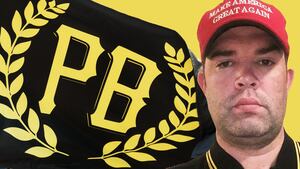When Trump supporters flooded D.C. on Jan. 6, many had traveled from hometowns where they felt like political outcasts—and where hate groups like the Proud Boys acted like a beacon for the far right, new research suggests.
Nearly 200 people are facing federal charges for their alleged attacks on the U.S. Capitol on Jan. 6. Prominent among them are members of the Proud Boys, a far-right paramilitary group that Canada designated as a terrorist organization on Wednesday. Even though most of the rioters were not Proud Boys, researchers from the University of Chicago and University of Michigan found that people who lived near Proud Boys chapters were more likely to have attended the riot or the rally that preceded it.
It’s not because Proud Boys only set up shop in solidly red areas, either. Rather, the researchers concluded, rally attendees were likely to have traveled from Republican-voting “islands,” where they felt—however unreasonably—besieged by nearby liberals, and where some Proud Boys chapters have gone recruiting.
The researchers used anonymized cellphone data to trace rally attendees back to their home neighborhoods. Unsurprisingly, many of those neighborhoods saw high turnout for Donald Trump in the 2020 election.
But researchers also wanted to look at the voting habits of surrounding areas.
“We wanted to see what happens when Trump supporters are isolated—that is to say, their communities were surrounded by other communities where support for Trump was lower,” Austin Wright, an assistant professor of public policy at the University of Chicago, told The Daily Beast.
He and his co-author found an increased rate of turnout from those areas. Wright attributed the phenomenon to “negative intergroup contact,” i.e. Trump supporters feeling threatened by neighboring liberals.
“People feel like they’re isolated or in some ways feel like they are being attacked or they’re under threat,” he said, adding that events like the Jan. 6 rally at the Capitol are “potentially one of the ways they can act out.”
His study points to longstanding research suggesting “that perceived isolation can trigger feelings of fear and subsequent aggression.”
<p><i><strong><em>Do you know something we should about Proud Boys, the far right, or the Capitol Riot? Email Kelly.Weill@TheDailyBeast.com or securely at </i>kellyweill@protonmail.com<i> from a non-work device.</i></strong></em></p>
Many rally attendees had something else in common: proximity to regional Proud Boys chapters. Even after taking into account an area’s pro-Trump leanings, and Republicans’ possible feelings of isolation, researchers found a significant correlation between Jan. 6 rally attendance and living near a Proud Boys headquarters.
Many of those chapters are located in blue or blue-bordering neighborhoods, where far-right Proud Boys might feel at odds with their neighbors.
The Southern Poverty Law Center’s list of Proud Boys chapters includes many city-level groups in typically Democratic or swing states. California, a solidly blue state that nevertheless hosts pro-Trump flash mobs, is home to multiple local Proud Boys chapters, the SPLC notes.
Some prominent Proud Boys charged in the Capitol attack hailed from chapters in predominantly blue regions. Nicholas Ochs, leader of Hawaii’s Proud Boys chapter, was charged with unlawful entry into the Capitol after he filmed himself inside the building. (Ochs, who recently led a longshot state Senate campaign as a Republican, posted a picture of himself with the caption “hello from the Capital lol” from his Twitter, where he uses the name “Dictator for Hawaii Elect Nick Ochs.”)
Two Proud Boys charged with conspiracy for their alleged attacks on the Capitol hail from liberal-leaning districts in New York. Dominic Pezzola and William Pepe both face 11 federal charges including conspiracy and, in Pezzola’s case, assaulting an officer—some of the most serious charges handed down so far in the attack (The Justice Department is reportedly considering using racketeering law for large conspiracy cases in the attack.) Neither man lives in a hardboiled red district, but in the Democratically-controlled cities of Rochester and Beacon, New York. Prosecutors on Wednesday also announced felony charges against the “sergeant-at-arms” of the Proud Boys’ Seattle chapter for his alleged role in the attack.
The Proud Boys openly lean into conflict with the left, hosting provocative rallies and engaging in brawls in blue cities on both coasts. (“Most of it is just to fight,” one former Proud Boy recently told CNN. "They want to join a gang. So they can go fight antifa and hurt people that they don’t like, and feel justified in doing it.”)
Proud Boys’ bloody recruitment ploys are not so different than the animosity that might have driven isolated Trump supporters to travel to D.C. on Jan. 6, Wright said.
Proud Boys attach themselves to “narratives of social displacement, which is a lot like isolation,” he said. This week, a popular Proud Boys chat channel was flooded with memes about white men supposedly losing their status in America, leading to calls in the group to ban immigration and revoke women’s right to vote.
“They play on narratives of threats to certain kinds of community, usually white supremacist communities, and the shifting role of the people in those communities,” Wright said.







